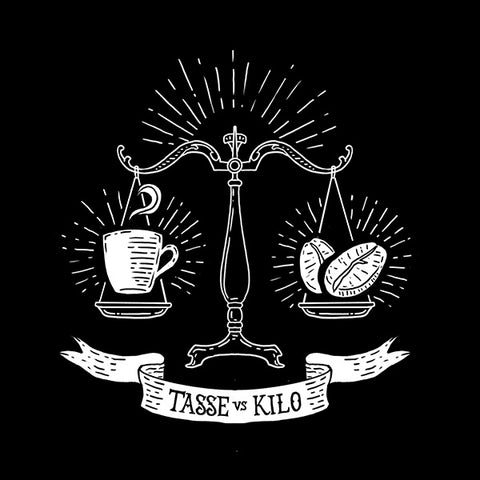You will understand my eternal surprise when the work of a roaster is presented with a touch of glamour. To roast using your “sampler”, with your eyes, your nose and your ears, to do cupping all week long, to spend your time discussing with producers, to travel… This idyllic, highly propagated version by the marketing of American roasters disconnects baristas from the real work of the roaster. This is why I liked Hoffman's text; we rarely hear a barista recognize this part of the work at its true value. So what is the real work of the roaster?
Consistency and repetition.
Of course, we do cupping. Once a batch of coffee is chosen, I roast 2 or 3 quantities of 200g at different roasting profiles. I taste and choose the profile to apply to my main roaster. There the creativity ends for roasting an original batch (blends are more creative given the assembly). Subsequently, the first roast is critical because I have to figure out how to apply my profile, created on a laboratory roaster, to my 30kg monster. Very different heat transfer, and there, I play the “sampler”, take notes, watch the coffee evolve, listen attentively to the arrival of the first crack, improvise a little the exotherm and cooling phase of the coffee. And there the art ends. If I am happy with the result, for the rest of the batch I will focus on following the exact same roasting curve and repeating it until the end of the batch. Consistency and repetition.
On a new batch of 100 70kg bags of coffee from Burundi, I will have to carry out around 235 roasts lasting around 20 minutes each.
So I will spend 78 hours roasting this coffee. If I consider that the roasting of my samples, the cupping and the duration of my first roasting took me 5 hours. This corresponds to 6% of the time. And it is this 6% which is put at the forefront and which is often the decision-making criterion of several baristas in the selection of a roaster!
And in this example, I'm talking about a new batch. If I consider a classic coffee, for example, the one we call Mexican velouté, we are talking here about a coffee from Mexico, from Chiapas, grade HG, roasted just after the first crack (city) that I bought year after year since 2005. It's the same coffee every year, same producer, same region. I roast about 280 bags a year. I do a quality test from time to time, adjust once a year if I see that the grain has changed a little with the new harvest, otherwise, it's “consistency and repetition”. My customers want coffee to taste the same every time! I put 30kg in the roaster, I follow the same curve relying on my digital controller, I wait for the 1st crack at the same degree, at the same time, I reduce the gases at the same time, I control the exothermic phase of the same way, I take out the coffee at the same temperature, and cool it in the same way and I carefully observe the coffee cooling to eliminate any beans that may have gotten stuck in the doors or on the edge of the tank. During this time, I reload the roaster with the next batch, bring the roaster to the chosen preheating temperature, and repeat the profile of this coffee, up to 25 times a day, focus, concentration. Nothing sexy about it.
Physically difficult.
Handling 70kg bags, unloading pallets, cleaning the parchment in the cyclone, intense heat, equipment breakdown, dust everywhere, breathing smoke, breathing gases from ground coffee, working with the door open in January, sweating its due in July. Flaring the roaster, sweeping the chimney… In short, the 94%. ;-)
Don't think I don't like my job. But, as Rolando mentions in his blog: […] Unfortunately, some slip-ups occur. Wanting too much to make cooking a spectacle, almost anyone starts to improvise anything. Forgetting that we work with living foods, the trivialization of the products used can be shocking for those who respect life as a whole.[…]
In my case, what is trivialized is the work of the craftsman. Real work from the roaster. I may not have the volume, financial means and team to allow me to compete with certain companies. But we give our all to be the best we can. This may not be reflected in the 6% but in the 94%, we are professionals, passionate about work.
I am currently in the process of moving my roasting workshop to its old premises on the Route du Quai. Next summer, many people will flock to sit in the espresso bar section, with a roasting workshop in the background. I have no idea what effect this new arrangement will have. Maybe some will enjoy seeing behind the scenes, others won't. This will also allow us to educate our customers on the process.
By showing you our 94% in an open space, I hope to be able to develop a less superficial relationship with my clients. Like in a relationship, or over the years, we take away the pressure to be sexy 100% of the time. It will take away the pressure of being a clone of XYZ roasting company, of trying to show that I too am sexy 6% of the time and even trying to be 50%. In my opinion, Twitter is a source of perverse information where we end up having the impression that roasters are doing the sexy job 100%, busy traveling the world, doing cupping, spending time in the laboratory. This is only the case for a few companies, which have built a solid marketing strategy (and which have the budgets) in this regard, and which have employees who do the hand work. We almost don't talk about that.
I believe that showing this aspect of the work will be beneficial, and that over time, we will see beautiful partnerships emerge in the coffee chain, based on the real work of each person, with respect and expertise for each person's role.


Comments (0)
There are no comments for this article. Be the first one to leave a message!